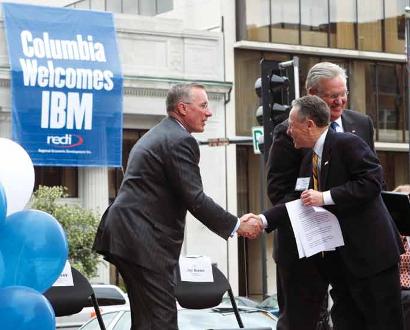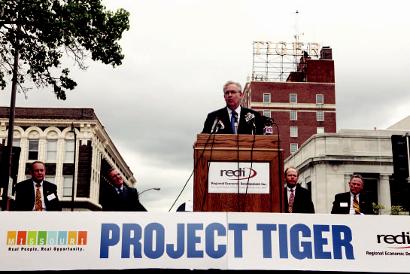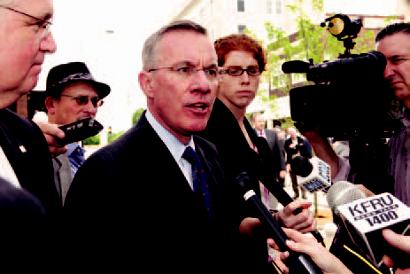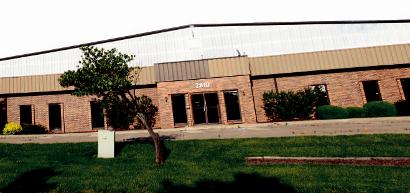How to Lure a Technology Titan

For the past several weeks, a team of attorneys had been frantically working to finalize leasing, financing and construction agreements. The stacks of paper represent the culmination of the community’s unprecedented effort to lure one of the world’s most revered companies to Columbia. In less than four months, a deal was struck that normally would have taken much longer.
After learning of IBM’s interest in late January, a full-court press — dubbed Project Tiger — by the city; REDI; Columbia Area Jobs Foundation; the state; and local business leaders, banks and attorneys ensued to meet IBM’s ferocious schedule. The result is an agreement that drew from the salesmanship, research and negotiating prowess of countless individuals.
“It’s a fast-track project; they want to be in operation by the fourth quarter of this year,” said Economic Development Director Mike Brooks. “There’s only one way to get there, and that’s everybody working together.”

Learning from CHIP
The call on Jan. 26 wasn’t the first from IBM. In the fall of 2008, the company gave the community a first look. REDI’s response — dubbed Project CHIP — produced an offer that would have provided the company with about 100,000 square feet of space by combining two buildings on Maguire Boulevard. But the market-rate lease terms didn’t get Columbia on the short list, and IBM never made a visit. In January 2009, the company announced it would locate a service center with potential employment of 1,300 in Dubuque, Iowa.
“The whole building situation was not compelling enough for them to come visit,” said Bernie Andrews, the president of REDI at the time. “We knew going into this one we needed to come out of the gate with our best deal, get them to visit and then let the community sell itself.”
In the year between IBM’s Dubuque announcement and the company’s second request for information from Columbia and the state of Missouri, a number of changes occurred. Boone County’s Chapter 100 Bond policy was amended to allow personal property sales tax abatement. The Columbia Area Jobs Foundation, the nonprofit entity serving as the intermediary for the city’s agreement with IBM, really got up and running. And REDI added a staff member to its roster — Brooks.
After the initial contact this January, REDI immediately went to then-Mayor Darwin Hindman to secure his support for an aggressive local incentive package that could provide a building below market rate. Hindman signaled his support in a letter included in the response to IBM.
“When I understood what was going on, I let it be known that I favored pretty much whatever it was going to take to take those steps,” Hindman said.

“We found out with project CHIP, there is no chance to negotiate if you don’t get them to visit the first time,” Andrews said.
The offer was apparently sufficiently attractive because on March 1, IBM executives arrived in town for their first visit.
Selling Columbia
On one of IBM’s early visits, Dave Griggs gave them a tour of the city on a Mo-X bus. They loved the parks and trails. They were impressed with downtown. The cost of housing blew them away.
“It’s a very easy job to sell Columbia,” he said.
The REDI team also made sure the company talked to the right people. During each of IBM’s three visits to Columbia, the executives were wined and dined amongst some of the community’s most notable players.
“It’s important to the company to know that it’s not just the economic development office that wants them,” Brooks said. “They expect that.”
Columbia Public Schools Superintendent Chris Belcher was brought in. UM System President Gary Forsee was present for two visits. Hindman was there selling Columbia. Local CEOs sat at the table.
The state was also heavily involved. Gov. Jay Nixon was present for the site visits and hosted the IBM executives at the Governor’s Mansion for dinner.
“Gov. Nixon really pulled the stops out to make this company feel welcome,” Griggs said.

“It wasn’t REDI or the city or somebody who maybe was a little overzealous in their sales pitch,” Griggs said. “I mean, they were talking one on one with (Staloch).”
As the negotiations progressed, and IBM’s interest became more apparent, the questions the company asked became incredibly specific, especially regarding the potential workforce.
“We were told right up front on workforce: ‘It’s going to take more than just you telling me you’ve got a workforce. You’re going to have to prove it,’” Griggs said. “They really grilled us.”
The company received presentations from local higher education institutions and commitments to revamp curricula to meet their needs. A lot of the research groundwork had been done during Project CHIP, but significant portions of the workforce information had to be updated. The level of detail IBM requested kept the REDI team working way past business hours, with responses often due within 24 hours.
“You don’t take a process that normally would minimally take six to nine months, at best, and condense it down into four months without quick turnaround and quick production,” Brooks said.
The community sales pitch never let up. While Hindman was in Washington, D.C., for the U.S. Conference of Mayors, he made a special stop by the IBM offices there.
“They were still holding their cards pretty close to the vest, but on the other hand, they had a lot of very nice things to say,” he said.
Hindman referenced a letter from IBM commending Columbia on its livability and the importance of that factor in the company’s deliberations about choosing a site.
“I can’t help but point out that (they) specifically mentioned the trails,” Hindman said.

“It wasn’t just about incentives; they could have gone anywhere,” said 1st Ward Councilman Paul Sturtz. “There are lots of communities that could put together a similar package. Columbia’s distinctive culture can’t be discounted.”
An Intense Schedule
City Counselor Fred Boeckmann, unlike most attorneys, doesn’t get paid by the hour. So he doesn’t know how much time he spent finalizing the financing, construction and leasing agreements with IBM. The best estimate he could offer was “a lot of hours.”
“Usually there’s more time to get something done, and usually the projects aren’t this significant,” Boeckmann said. “I cannot think of anything comparable.”
He’s worked the past three weekends, and the other local attorneys involved in the deal — Craig Van Matre, who represented the local banking group; Erick Creach, who represented CAJF; and Bruce Beckett, who represented the LeMone Trust — scrambled to finalize the agreements between the involved parties and IBM as the deal neared the final stages. Time had been of the essence from the beginning, with IBM insisting on having an operational facility by Nov. 1.
“I’ve been doing this work for a long time, and I’ve never had a project on this tight of a time schedule, not at this magnitude,” Brooks said.
The agreement ultimately reached was given the nod by the City Council at a special meeting on May 24. CAJF will buy the building from the LeMone Trust with a $500,000 contribution from the city and enter into the financing agreement with local banks. The banks will make up to $10 million available for the building’s renovation. After CAJF finalizes agreements with the banks and the general contractor, Little Dixie Construction, it will hand over ownership of the building to the city, which will pay down the $2.55 million balance on the building with rent from IBM. IBM’s contract allows it to basically write one check for property management, utilities and payments in lieu of taxes, all of which will go to paying off the construction and building loans.

“We didn’t have the time, and we didn’t have the legal ability to do it with the city as the owner and with the city as developer, so we had to have a private developer step in to do all this,” he said.
The city’s de facto purchase of the building is the first time Columbia has ever taken such an action. But ironing out the differences to get to a final agreement required some savvy — and sometimes heated — negotiations.
At one point Van Matre said he accused Boeckmann of “going postal” — a clear indication for anyone who knows the soft-spoken city counselor that the dialogues got intense.
“We had some frank and spirited conversations with the IBM people about what they wanted, which was the moon, and what we could give them, which was something considerably less,” Van Matre said.
Technically, there is still a “window of risk,” as Van Matre put it. IBM has the right to withdraw from the agreement until the beginning of July if the state incentives don’t materialize. But that’s a significant difference from where the negotiations commenced, when the company wanted the right to scrap the deal any time before they occupied the building.
“The banks could not justify putting $10 million out and hoping IBM didn’t find some reason they wanted to walk away,” Van Matre said.
The ball is in the state’s court now, the promised incentives the last piece of the puzzle that needs to fall into place. Those involved said there is no reason to believe the state won’t come through.
“There’s just too many people who would have major egg on their faces, going all the way up to the governor of the state,” Van Matre said.
Meanwhile, construction and design specifics were also being finalized. Ultimately, Little Dixie and the LeMone Trust ended up with a significant business deal securing a construction contract potentially worth $10 million and selling an underutilized building. But convincing IBM of the structure’s potential was one of the project’s more significant obstacles.
“I was very positive from the initial phone call that Columbia had a great opportunity to bring IBM to the community,” said John States, one of the owners of Little Dixie.
Little Dixie was grilled by IBM on cost estimates and required to produce job quotes and estimates under “phenomenal time pressures,” Watkins said. The team the firm assembled to sell the building’s potential to IBM had the challenging job of demonstrating how it would convert a warehouse — not long ago filled with some cars, an old forklift and “lots of dirt,” according to Griggs — into a corporate office.
“Part of the challenge that you face when you’re trying to make this kind of conversion is getting people to see the vision of what it can be, not what it is,” Brooks said.
States gives lots of credit to the architect, John Simon of Simon Associates, in convincing IBM of the building’s potential. But oftentimes IBM would ask for definitive cost estimates and designs without many specifics on what it wanted, Griggs said.
“What do you want in the space; how do you want the space configured?” he said. “We knew nothing.”
But after all the wrangling concluded, Watkins said the city did not depart much from its original proposal.
“We had to go through some different machinations to make it work legally, but it is pretty much the same basic offer that was put on the table back then,” he said.
Carrots for Companies
The significance of the IBM deal, apart from the jobs and community investment, is the change in the community’s willingness to offer incentives. When Watkins was economic development director and helped lure Quaker Oats to Columbia in the mid-’90s, the only incentive they were offered was a sewer line, he said.
“For a while, over the past eight to 10 years anyway, the community was not looked at by a lot of businesses because we didn’t put things on the table,” Watkins said. “We kind of said we’re a good enough community; we don’t have to do that.”
These days, Andrews said REDI is hearing from more companies interested in the community than at any time in his history, and he gives credit to the change in the community’s willingness to craft incentive packages.
“We were getting eliminated before we even got contacted,” he said.
Former 4th Ward City Councilman Jerry Wade said the IBM deal is the result of efforts that intensified during the past five years to put the tools in place for high-tech economic development.
“It’s not so much what happened from January to the present; it’s what happened from 2006 to 2010,” Wade said. “There was no question that at some point we would hit some biggies.”
As for Watkins, IBM is the “biggest fish” that Columbia has landed since he has been here, he said. He pointed to the area’s willingness to start using tools such as Tax Increment Financing and Chapter 100 Bonds, as well as specific measures such as the approval of electricity discounts for large power users.
“The community, particularly the council, and I give the previous council a lot of credit, was willing to consider these kind of things for the right project,” he said.
Griggs pointed to the university’s adoption of economic development as a core mission, its establishment of the Life Sciences Incubator and its growing collaboration with local government and REDI.
A watershed year was 2004, when REDI began reviewing its incentive policy, Griggs said.
“Never in history had the word incentive been met with anything other than, ‘We don’t do that,’” he said.
Changing Columbia’s Economy
The implications for Columbia’s economy loom large. With a company as significant as IBM making a public announcement, Columbia’s reputation as well as its economy will get a boost.
“For the companies that are considering Columbia or who have recently considered Columbia but have not pulled the trigger on whatever project they’re working on, this sends a really big signal,” Griggs said.
The $77 million impact Brooks derived from a Federal Reserve model assumes $33 million in ripple effects from the $44 million payroll IBM will potentially generate. But the publicity is also significant, as is the continued growth in IT jobs, he said.
“With the addition of this company, it’s just going to make our technology job base just that much more noticeable and significant,” he said.
In Dubuque, the city has already begun to see itself transform due to the effects of IBM’s investment there, said Rick Dickinson, president of the Central Dubuque Development Corporation. Columbia can expect similar results, he said.
“Ten years ago, you could have shot a cannon down Main Street Dubuque,” he said. “Now, it’s a vibrant business center.
“It will change the dynamics of your economy nearly overnight.”
Although some members of the community have already expressed skepticism about the incentive package offered to the company and the secretive manner under which the deal was negotiated, those involved said the incentives and confidentiality request are standard. IBM got a good deal, they said, but so did Columbia.
“Anybody who thinks we made a mistake in doing what we did is just flat wrong,” Van Matre said. “This deal had to happen to turn the town around.”


